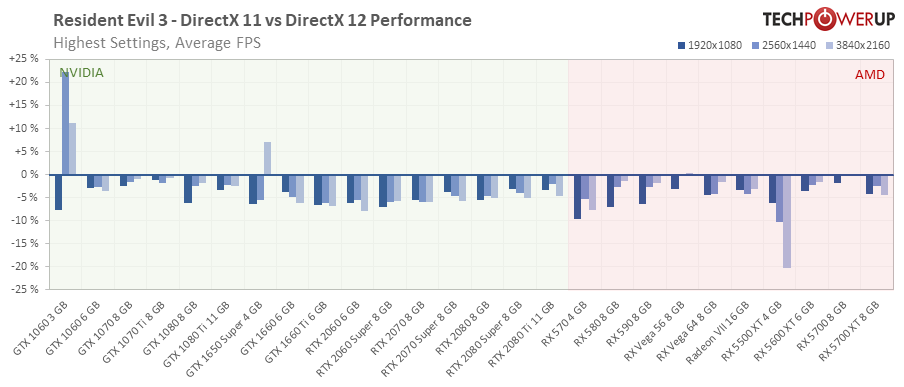 46
46
Resident Evil 3 Benchmark Test & Performance Analysis - 27 Graphics Cards Compared
Conclusion »Test System
| Test System | |
|---|---|
| Processor: | Intel Core i9-9900K @ 5.0 GHz (Coffee Lake, 16 MB Cache) |
| Motherboard: | EVGA Z390 DARK Intel Z390 |
| Memory: | Thermaltake TOUGHRAM, 16 GB DDR4 @ 4000 MHz 19-23-23-42 |
| Storage: | 2x 960 GB SSD |
| Power Supply: | Seasonic Prime Ultra Titanium 850 W |
| Cooler: | Cryorig R1 Universal 2x 140 mm fan |
| Software: | Windows 10 Professional 64-bit Version 1909 (Sep 2019 Update) |
| Drivers: | AMD: Radeon Software 20.4.1 Beta NVIDIA: GeForce 445.75 WHQL |
| Display: | Acer CB240HYKbmjdpr 24" 3840x2160 |
We tested the press review version of Resident Evil 3. We also installed the latest drivers from AMD and NVIDIA, both of which have game-ready support for the game.
Graphics Memory Usage

Using a GeForce RTX 2080 Ti, which has 11 GB of VRAM, we measured the game's memory usage at the highest setting.
At lower resolution, Resident Evil 3 will consume around 5-6 GB VRAM, which can be challenging for cards with 3 GB or 4 GB.
For higher-end cards, 8 GB VRAM usage is spot on, making best use of the resources as that's the most commonly available memory capacity.
GPU Performance (DirectX 11)



GPU Performance (DirectX 12)



DirectX 11 vs DirectX 12 Performance

Across the board, DirectX 12 performance is worse than DirectX 11.
FPS Analysis
In this section, we're comparing each card's performance to the average FPS measured in our graphics card reviews, which is based on a mix of 22 games and should provide a realistic average covering a wide range of APIs, engines, and genres.

Jan 15th, 2025 10:48 EST
change timezone
Latest GPU Drivers
New Forum Posts
- Will DDR6 rams be released this year? (11)
- Poll: Do you think the 5090 will be thermally or power limited? (17)
- Strange issues with 5800x and ASRock B450M Pro 4 (0)
- X299 Owners Club (159)
- Are people planning an upgrade? (315)
- AGESA PI 1.2.0.3 benchmarked. (2)
- upgrade rtx 4090 for an Rtx 5080 (100)
- Postulation: Is anyone else concerned with the proliferation of AI? (249)
- Need help for CPU and Motherboard (6)
- What are you playing? (22600)
Popular Reviews
- AMD Ryzen 7 9800X3D Review - The Best Gaming Processor
- ThieAudio Origin In-Ear Monitors Review - Basshead Love
- ASUS ROG Strix B860-A Gaming Wi-Fi Review
- NVIDIA GeForce RTX 50 Technical Deep Dive
- LAMZU Maya X Review
- ASUS ROG Strix B850-F Gaming WiFi Review
- GPU Test System Update for 2025
- Upcoming Hardware Launches 2024 (Updated Nov 2024)
- Arrow Lake Retested with Latest 24H2 Updates and 0x114 Microcode
- DDR5 Memory Performance Scaling with AMD Zen 5
Controversial News Posts
- NVIDIA 2025 International CES Keynote: Liveblog (468)
- AMD Debuts Radeon RX 9070 XT and RX 9070 Powered by RDNA 4, and FSR 4 (348)
- NVIDIA GeForce RTX 5090 Features 575 W TDP, RTX 5080 Carries 360 W TDP (212)
- AMD Radeon RX 9070 XT Alleged Benchmark Leaks, Underwhelming Performance (204)
- 32 GB NVIDIA RTX 5090 To Lead the Charge As 5060 Ti Gets 16 GB Upgrade and 5060 Still Stuck With Last-Gen VRAM Spec (174)
- Potential RTX 5090 and RTX 5080 Pricing in China Leaks (173)
- AMD Radeon RX 9070 XT Boosts up to 3.10 GHz, Board Power Can Reach up to 330W (167)
- AMD Radeon RX 9070 XT Tested in Cyberpunk 2077 and Black Myth: Wukong (164)